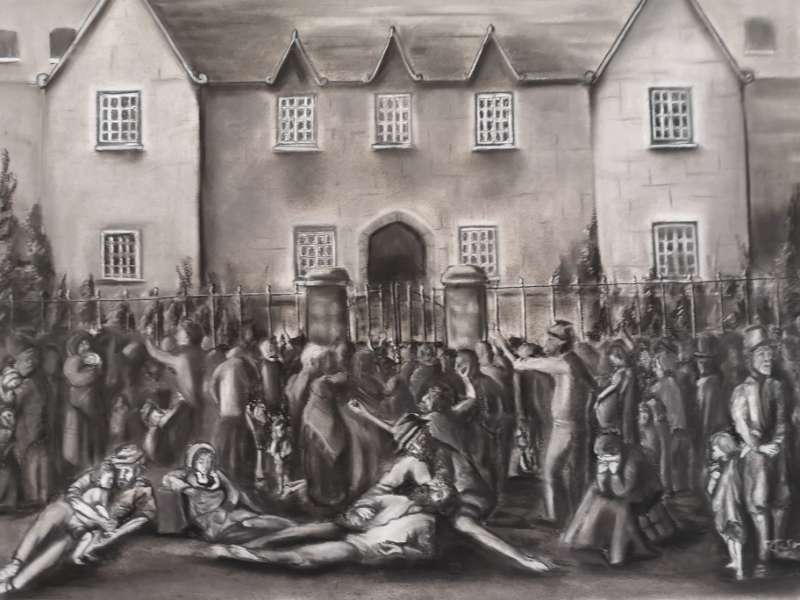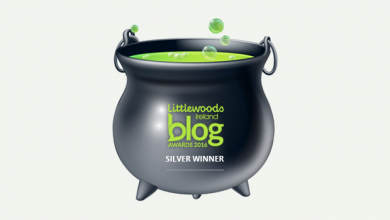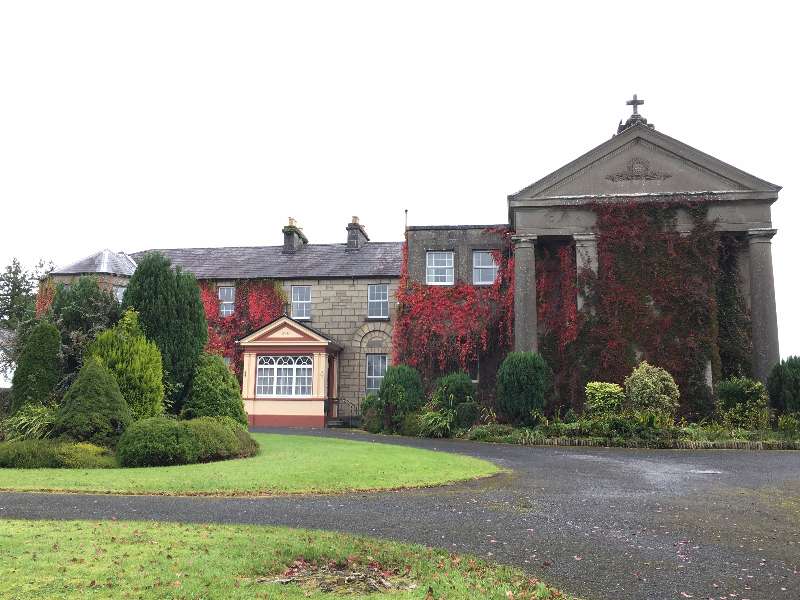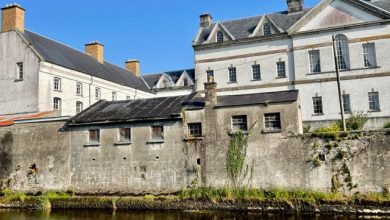Events
Dr Jason King’s book launch speech

- Good evening. I am Dr Jason King, and I work with the Irish Heritage Trust and National Famine Museum at Strokestown Park.
- It is a great honour and a real pleasure for me to have been invited here to King House this evening to help launch Barry Feely’s book, We Are The Survivors: Boyle Workhouse & Emigration in Famine Times.
- As Tony Conboy notes, this is a book not only about the Boyle Workhouse. It also uses it as a “cornerstone” for a study of the workhouse system, the wretched conditions experienced by its inmates struggling to survive the ravages of the Great Hunger, and its local impact here in Boyle and Roscommon, as well as across Ireland and indeed the destinations in Australia, Canada, the United States where emigrants from Boyle sought to escape and start new lives overseas.
- Barry Feely is a stone cutter and stone carver by trade, from a long family line of stone carvers, and this is reflected, I think, both in his exquisite attention to detail and respect for craftsmanship throughout the book.
- One of the first things we learn in We are the Survivors is about the lingering shame and sense of stigma associated with the Workhouse in Boyle – indeed all workhouses – long after the workhouse system itself was abolished in Ireland in 1925 and the physical building of the Boyle workhouse was demolished in 1974, when it was replaced by the Plunkett Home.
- Even as the remnants of the Boyle Work House were coming down, Feely notes , the newly arrived Dr Martin Fallon and his wife Mary had their gift of a punnet of strawberries returned to them from their neighbours because they were grown on the workhouse grounds.
- And yet, as Feely also recalls, the workhouse building could also provide a warm and sheltering environment for happy memories when it became the District Hospital, where the author visited his uncle James Feely: “sitting at the roaring turf fire with his fellow patients from by-gone days. The warm glow of the open turf fire seemed snug and secure as they drank a mug of tea, occasionally spitting into the fire and taking the odd pull of a Woodbine cigarette when Nurse Annie Coen was out of sight”.
- As I have said, one of the first things that strikes you about this book is its exquisite attention to detail and exploration of the local history and geography of Boyle.
- It is a book that helps us reimagine the lives of those who were most afflicted by the Great Hunger, the cottiers or landless agricultural labourers, especially when it takes us inside their modest dwellings where they struggled to survive.
- I was moved by Barry’s detailed description of his visit with his brother Joseph to the Famines House of Sheegora Boyle “built with dark brown sandstone from the local area [with] roofs… thatched with reeds” (15)
- The images of the house, American trunk, and pooch bed on page 15 give us the visual aids to imagine the lives of its inhabitants before their lives were devastated by the Famine and so many people from the area were forced to leave humble but comfortable dwellings like these to seek entry to the workhouse, to emigrate, or, indeed, to all too often perish in the open.
- The book also brings a local eye to the often hidden or overlooked final resting places and cemeteries of the Famine dead: whether it be the Plunkett Avenue Famine Memorial Graveyard in Boyle (41), the Father Jospeh McTucker monument (42), or the simple field stones for the Famine Dead in the old part of the Ardcarne burial area (44).
- Indeed, Barry brings a stone carver’s perspective to the Killaraght Famine Burial Area where many of the stones – he points out – were taken from St. Attracta’s medieval church.
- Though the Famine dead have no inscriptions on their burial markers here, the ecclesiastical stone work, such as ornamental champers, which record their passing pay silent tribute to them, as does the expertise with which Barry Feely surveys their place of rest.
- The book We are the Survivors itself is also a work of craftsmanship with its evocative period sketches by Michelle Simon which help bring the workhouse regime to life in her vivid re-imagining of it, especially as it was experienced by little children, as well as the poignant documents and photographs that Barry has discovered and reproduced, such as the powerful undated cover photograph by David Derby of children standing in front of the Boyle Workhouse entrance on pages 74-75.
- No less poignant are Michelle Simon’s illustrations of “People in desperation waiting to be admitted to Boyle workhouse” (28-29), “Sheegora Evictions with Lough Key in the Background” (13), “Children Waiting for their food in the Workhouse” (23), “Women and Children in the hold of the Digby ship en route to Auastralia” (84), “Bianconi long cart leaving Boyle workhouse” (87).
- These images complement and help us envision the lives of workhouse inmates, and especially the blighted life cycle of its child inhabitants, alongside the documents that Barry had discovered such as the “Boyle Union Workhouse Order List” (69) to make this book such a vivid reconstruction of an institution that most people feared and sought to forget.
- It is also ironic that as we stand here this evening in the lavish surroundings of King House – the home of the landlord who helped administer the workhouse and so often filled it with former tenants cleared from his estate – that we launch Barry Feely’s book We are the Survivors that shifts our attention to those who survived within its grim chambers and walls.
- They are the extraordinary details that Barry focuses on with his craftsman’s eye that enables us to shift our perspective from privilege to privation, from this lavish interior to the lives documented in the book.
- Not only does We are the Survivors distinguish itself in its attention to detail and excavation of local history and stories of the Boyle workhouse, but it also takes us far afield in tracking the lives of former inmates after they were assisted to emigrate to Australia, Canada, and the United States.
- Barry has collaborated and worked closely with our speaker from the Irish Famine Summer School in Strokestown, Perry McIntyre, to trace and reconstruct the lives of young women and girls from the Boyle workhouse who participated in the Earl Grey female orphan emigration scheme whereby they left Roscommon to start new lives in Australia
- We get a profile of some of these women on the Tippoo Saib Ship (89), accompanied by some evocative illustrations and photographs, as well as correspondence with their descendants.
- In this way, Barry Feely shifts our attention from the intensely localized study of the Boyle workhouse, that is the focus of the first two chapters of the book, to its global significance: as a place of origin for a widely scattered Irish diaspora peopled by survivors of the Great Hunger who demonstrated great resilience in resettling overseas and starting new families whose descendants return to Boyle today.
- I want to conclude my remarks by observing some of Barry Feely’s other works of craftsmanship that pay tribute to the Famine Irish in Canada alongside which his book We are the Survivors takes its place.
- As he mentions on pages 96-97, Barry accompanied Jim and Adeline Callery to Quebec City in the year 2000 for the erection of the 10ft Celtic Cross memorial that Jim donated to the people of Quebec for caring for Famine Irish emigrants and adopting Irish orphans after the horrendous migration of 1847.
- He had the opportunity to meet the late Marianna O’Gallagher and Leo Tye, grandson of Strokestown Famine orphan Daniel Tighe who adopted and inherited the family farm in Lotbiniere Quebec, whose own son Richard Tye made a return journey to Strokestown for the Gathering in 2013. I had the pleasure of visiting Lotbiniere and meeting Richard Tye this past summer and visiting the magnificent Celtic Cross Famine memorial in Quebec City.
- This Celtic Cross, that Jim Callery donated to the people of Quebec, was made by Barry’s very own Feelystone stone carving company, founded in 1790.
- As he recalls: “The cross was carved by Eileen Brannigan, depicting panels from many of the iconic crosses around Ireland. The cross was generously donated by Jim Callery and his wife Adeline from Strokestown Famine Museum as a gift from the people of Ireland to the people of Quebec in gratitude for their help during the famine times”.
- Barry also notes that Feelystone were “involved with the construction of the limestone memorial at Ireland Park in Toronto”, a magnificent Famine memorial that also features Rowan Gillespie’s sculptures of Famine migrants arriving in Canada that are the counterpart to his Famine Memorial sculptures in Dublin. I am the historical advisor for Ireland Park Foundation and have visited Ireland Park a number of times.
- These Feelystone Famine memorials of the Celtic Cross in Quebec City and Ireland Park in Toronto are themselves exquisite works of craftsmanship that link Boyle and Roscommon with the wider Famine Irish diaspora, and pay tribute, like Barry Feely’s book We are the Survivors, to those who perished and survived the Great Hunger in Ireland and abroad
- The book is a great work of scholarship and craftsmanship in its own right, and I commend it to you.




